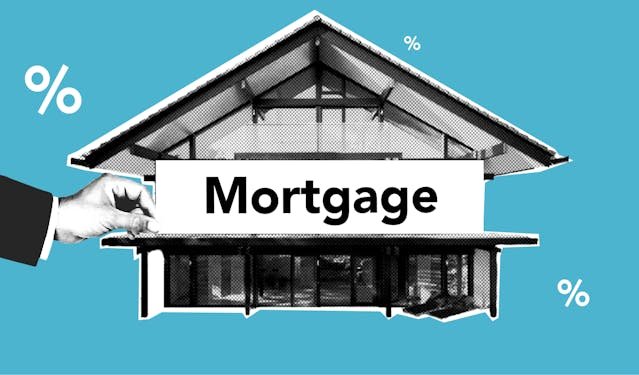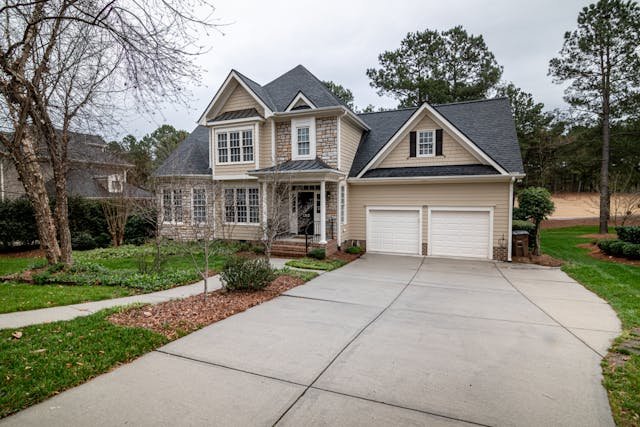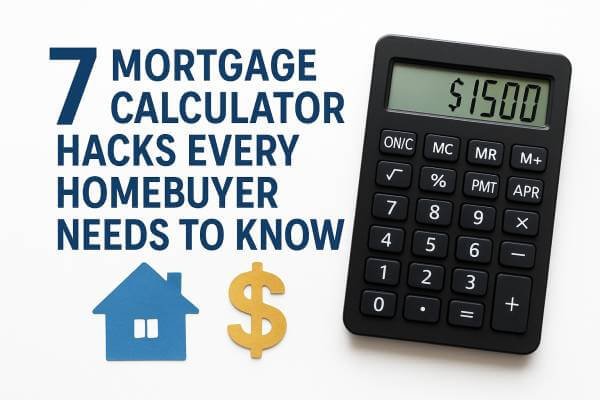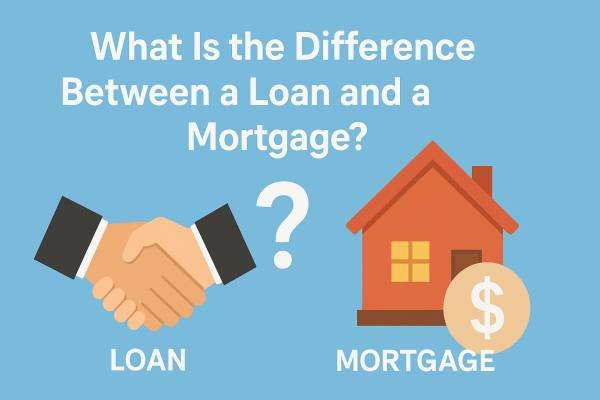Step-by-Step: How to compare mortgage loan rates as a First-Time Homebuyer

When you take the time to compare mortgage loan rates, you’re not just shopping around; you’re saving yourself potentially tens of thousands of dollars down the line.
Wouldn’t you agree that it’s wise to compare models, prices, and features before purchasing a new car? So why would you jump into a 30-year home loan without doing the same?
Maybe you’re feeling a little lost or overwhelmed by the process. That’s totally normal. But don’t worry; this guide will break down everything you need to know about mortgage loan comparisons step-by-step so you can confidently snag the best deal possible.
Step 1: Understand the Basics of Mortgage Loans
Before you begin to compare mortgage loan rates, let’s cover some basics. To be honest, how can you effectively shop for something if you don’t fully understand what you’re shopping for?
Here is an explanation of all the essential information, guaranteed to keep your eyes open.
What Exactly Is a Mortgage Loan?
A mortgage loan is basically the money you borrow from a lender to buy your home. In exchange, the house acts as collateral, which means if you stop paying, the lender could eventually take the house back. Scary? Maybe a little. But understanding the details helps you choose wisely and confidently.
Different Types of Home Loan Options
Did you know you have several different types of mortgage loans to choose from? Mortgages come in different shapes and styles, each suited to different situations.
- Conventional Loans:
These are pretty standard and not backed by the government. Usually, you need decent credit and a down payment of at least 3% to 5%. Great if your financial situation is fairly straightforward. - FHA Loans:
If your credit’s not perfect or your down payment is smaller, FHA loans are a friendly option. They’re government-backed and often require only about 3.5% down. - VA Loans:
If you’re a veteran, active-duty service member, or qualifying spouse, VA loans are hard to beat. They typically offer excellent rates and require no down payment at all. - USDA Loans:
Are you planning to buy in a rural area or a smaller town? USDA loans offer zero-down financing to encourage growth in these communities. Isn’t that pretty cool?
Fixed-Rate vs. Adjustable-Rate Mortgages (ARM)
Here’s a biggie: Should you go fixed-rate or adjustable-rate?
- Fixed-Rate Mortgages:
This type has one interest rate that stays the same for the life of your loan, usually 15 or 30 years. It’s predictable, steady, and stress-free. This type of mortgage is ideal for those who value stability and dislike unexpected changes. - Adjustable-Rate Mortgages (ARM):
With ARMs, your rate is fixed initially (usually for 5–10 years) and then adjusts periodically based on the market. These often start lower but can rise later, making them ideal if you plan to move or refinance after a few years.
How Do Mortgage Lenders Actually Make Money?
When you compare mortgage loan rates, you might wonder, how exactly does the lender make a profit?
Lenders primarily make money through interest, which is the additional amount you repay on top of the borrowed sum. They also charge fees for things like processing, origination, and underwriting. That’s why it’s critical to look beyond just the interest rate. Fees matter too, and knowing the details will help you snag the best deal overall.
Step 2: Gather Loan Estimates from Multiple Lenders
The next step to effectively compare mortgage loan rates is to collect actual offers, or “loan estimates, from multiple lenders. Trust me, this part might seem tedious, but it’s absolutely worth your time. The difference can literally save you thousands!
Why Get At Least 3–5 Loan Estimates?
Lenders compete for your business, and rates and fees can vary significantly. Getting 3 to 5 loan estimates ensures you’re not missing out on savings. Plus, it gives you leverage to negotiate better terms.
What Exactly is a Loan Estimate?
A Loan Estimate (LE) is a standardised document lenders provide that outlines everything you need to know about their offer, including:
- Interest Rate: The percentage you’ll pay for borrowing the money.
- Monthly Payments: The amount you’ll owe each month.
- Closing Costs: A breakdown of fees you’ll pay upfront to close your loan.
- Loan Terms: How long you’ll have to repay the loan (usually 15 or 30 years).
- Total Cost of the Loan: Including fees and interest over the loan’s life.
This document is an invaluable tool for comparing mortgage loans.
Requesting Loan Estimates Without Hurting Your Credit
Here’s something super important: You can, and should, shop around without damaging your credit score. Credit scoring agencies typically allow a 30- to 45-day window where multiple credit checks from mortgage lenders count as just one inquiry.
So, go ahead and request multiple estimates within that timeframe without fear.
Make Your Own Mortgage Comparison Spreadsheet
Want a simple tip that will make your life way easier? Create your own spreadsheet. It doesn’t have to be fancy. Just include these columns:
- Lender Name
- Interest Rate
- APR (Annual Percentage Rate)
- Monthly Payment
- Loan Term (15 or 30 years)
- Closing Costs
- Fees (Origination, Processing, etc.)
- Notes (any special terms or benefits)
Each time you get a loan estimate, plug the details into your spreadsheet. Your spreadsheet will clearly show you which lender is offering the best overall deal.
If spreadsheets scare you, don’t panic; I’ll provide a simple template later in this guide to help you effortlessly compare mortgage loan rates.
Step 3: Know the Key Terms in a Mortgage Loan Estimate
You’ve got your loan estimates in hand. Awesome! But now comes the tricky part: understanding exactly what those documents mean. Don’t stress; I’ll walk you through all the key terms in plain English. This way, when you compare mortgage loan rates, you’ll know exactly what you’re looking at.
Interest Rate vs. APR: What’s the Difference?
Have you ever pondered why loan documents display two distinct percentages, the interest rate and the annual percentage rate? Here’s the detailed explanation:
- Interest Rate: This number is the cost of borrowing the money itself, shown as a percentage. It’s the base cost you pay each year to your lender.
- APR (Annual Percentage Rate): APR includes your interest rate plus additional fees, like origination and processing charges. Basically, it gives you a clearer picture of the loan’s true cost.
When you compare mortgage loan rates, pay attention to the APR; it reveals hidden costs the base interest rate won’t show.
Monthly Principal & Interest Payment
This breakdown shows the exact amount you’ll pay monthly towards your loan itself. It includes:
- Principal (the actual borrowed money)
- Interest (the fee charged for borrowing)
Keep in mind your total monthly mortgage bill often also includes taxes and insurance.
Loan Term (15-Year vs. 30-Year)
Simply put, the loan term is how long you have to repay your mortgage:
- 30-Year Loans: Lower monthly payments but more interest paid over time.
- 15-Year Loans: Higher monthly payments, but you save big on total interest and pay off your loan quicker.
Which is better? It depends on your budget and how quickly you want to own your home outright.
Estimated Taxes and Insurance
Property taxes and homeowners insurance are usually added to your monthly payment and held in an escrow account. Lenders estimate these costs on your loan estimate. Be sure to double-check these numbers; they directly affect your total monthly cost.
Origination Charges and Discount Points
These are upfront lender fees you’ll see on your estimate:
- Origination charges: Fees for processing your loan paperwork.
- Discount points: Fees you pay upfront to buy down your interest rate (optional, but can save you money over the life of your loan if you plan to stay in your home long-term).
Lender Credits (What Do They Really Cost?)
Lender credits sound great; they reduce your upfront closing costs. But there’s a catch: typically, the lender offers these in exchange for a slightly higher interest rate, which means higher monthly payments. Always run the math and see if lender credits truly benefit you.
Prepayment Penalties (Avoid at All Costs!)
Prepayment penalties punish you if you pay off your mortgage early. Most lenders don’t include these nowadays, but double-check anyway. You never want to get stuck paying extra just for being financially responsible.
Step 4: Compare the Real Cost of Each Loan Offer
You’ve got your loan estimates and understand the key terms. Now comes the fun part: putting everything side-by-side and clearly seeing which loan offer gives you the best deal. When you compare mortgage loan rates, it’s essential to look beyond just the rate itself.
Total Loan Cost: Short-term vs. Long-term
One of the biggest mistakes first-time buyers make is only looking at monthly payments. While lower monthly payments may seem appealing initially, what is the overall cost in the long run?
Ask yourself these questions:
- How much interest will I pay over the entire loan term?
- How does the total cost differ between a 15-year and a 30-year loan?
Perform mathematical calculations or utilise a mortgage calculator when comparing loan offers. You’ll quickly see that small differences in rates and terms can add up to tens of thousands of dollars over time.
Monthly Payment Comparisons
Of course, monthly payments matter too. You need a home loan you can afford comfortably. Place each loan’s monthly payment next to each other; don’t forget taxes and insurance!
Ask yourself:
- Can I comfortably afford this payment without sacrificing my lifestyle?
- Is it worth stretching my budget for a shorter loan with higher monthly payments but less total interest?
Cost of Mortgage Insurance (PMI or MIP)
Mortgage insurance protects the lender if you stop paying. If your down payment is less than 20%, most lenders require this insurance:
- PMI (Private Mortgage Insurance): Usually required for conventional loans.
- MIP (Mortgage Insurance Premium): Required for FHA loans.
When you compare mortgage loan rates, factor in these insurance costs; they add to your monthly payment, sometimes significantly.
Breaking Down Closing Costs (Where to Save Money)
Closing costs can seriously add up (think thousands of dollars). Look at the breakdown closely:
- Origination fees
- Appraisal fees
- Title insurance
- Attorney fees
- Recording fees
Every lender charges these fees differently. Don’t hesitate to ask, “Can you waive or reduce this fee?” or “What’s negotiable?” You’d be surprised how often lenders say yes, especially when competing for your business.
Real-World Example of Comparing Loans
Let’s quickly illustrate this with a realistic scenario:
Loan Option A:
- Interest Rate: 6.25%
- APR: 6.40%
- Monthly Payment: $1,850
- Closing Costs: $7,500
Loan Option B:
- Interest Rate: 6.00%
- APR: 6.20%
- Monthly Payment: $1,790
- Closing Costs: $9,000
At first glance, Option B seems better due to a lower rate and monthly payment, right? But when you factor in higher closing costs, Option A might save you upfront if cash is tight, while Option B saves you long-term if you plan to stay put for many years.
The point is, the best mortgage for you depends on your personal financial goals and timeline.
… To continue reading the remaining guides on the next page, click this link:
Step-by-Step: How to Do Mortgage Loan Rate Comparison as a First-Time Homebuyer
Frequently Asked Questions (FAQ)
1. Why should I compare mortgage loan rates before choosing a lender?
Comparing mortgage loan rates helps you find the best deal—not just in interest, but in fees, monthly payments, and total cost over time. Even a small rate difference can save you tens of thousands of dollars over the life of a loan.
2. How many mortgage loan offers should I compare?
Experts recommend getting loan estimates from at least 3 to 5 lenders. This gives you a clearer view of available rates, fees, and loan terms so you can confidently choose the most affordable option.
3. Does shopping for mortgage rates hurt my credit score?
Not if you do it right. Multiple credit checks for mortgage rate shopping within a 30–45 day window typically count as a single inquiry. This procedure allows you to compare offers without damaging your credit.
4. What’s the difference between interest rate and APR?
The interest rate is the cost of borrowing money, while the APR (Annual Percentage Rate) includes that plus lender fees, points, and other costs. APR gives a more complete picture of a loan’s true cost.
5. What fees should I look for when comparing mortgage loans?
Key fees to compare include
- Origination fees
- Discount points
- Application or underwriting fees
- Title and appraisal fees
These vary by lender and can impact your overall loan cost.
6. Are online mortgage lenders better than local banks?
It depends. Online lenders may offer lower rates and faster approvals, while local lenders can provide personalized service and in-depth knowledge of local market conditions. Comparing both types is often the smartest move.
7. Should I choose the lowest rate or the lowest monthly payment?
Choosing the lowest rate or the lowest monthly payment is not always the same thing. A lower rate might come with higher fees, and a lower monthly payment could stretch your loan term, costing more in the long run. It’s best to look at the total loan cost, not just one number.
8. Can I negotiate mortgage rates or fees with lenders?
Yes, absolutely. Many lenders are willing to match or beat competitor offers or waive certain fees to win your business, especially if you have excellent credit and multiple loan estimates.
9. What should I do if two loan offers are nearly identical?
If rates and fees are close, consider other factors like
- Lender reputation
- Responsiveness and customer service
- Rate lock period
- Flexibility with closing timelines
These details can make a big difference in your overall experience.
10. What happens after I choose a mortgage loan?
Once you select a loan, you’ll:
- Lock your interest rate
- Complete the underwriting process
- Receive a Closing Disclosure
Attend your closing appointment and sign final paperwork.
After that? You get the keys and officially become a homeowner!
… To continue reading the remaining guides on the next page, click this link:
Step-by-Step: How to Do Mortgage Loan Rate Comparison as a First-Time Homebuyer
Footnotes & Sources
This guide on comparing mortgage loan rates references the following authoritative sources to ensure accuracy and provide trusted insights:
- Freddie Mac—Primary Mortgage Market Survey (PMMS)
https://www.freddiemac.com/pmms
(Weekly data on average U.S. mortgage interest rates and historical rate trends.) - Mortgage Bankers Association (MBA)—Weekly Mortgage Applications Survey
https://www.mba.org/news-research-and-resources/research-and-economics
(National trends on mortgage application volume and rate activity.) - FICO—Average U.S. Credit Score Trends
https://www.fico.com/blogs
(Statistics on consumer credit health and credit score distribution.) - Consumer Financial Protection Bureau (CFPB)—Mortgage Shopping Behavior Study
https://www.consumerfinance.gov/data-research/research-reports/
(Insightful data on how consumers compare mortgage offers and lender transparency.) - National Association of Realtors (NAR)—Profile of Home Buyers and Sellers
https://www.nar.realtor/research-and-statistics
(Comprehensive data on first-time buyer behavior, financing methods, and home search trends.) - U.S. Census Bureau—Homeownership and Housing Statistics
https://www.census.gov/housing/hvs/
(Quarterly stats on homeownership rates and first-time buyer participation.) - Federal Housing Finance Agency (FHFA)—Mortgage Data & House Price Index
https://www.fhfa.gov/DataTools/
(Loan performance metrics and market data on home financing and pricing.) - Urban Institute – Housing Finance at a Glance: Monthly Chartbook
https://www.urban.org/policy-centers/housing-finance-policy-center/projects/housing-finance-glance-monthly-chartbook
(Monthly snapshots of mortgage origination trends and market share by loan type.) - CFPB – Loan Estimate Explainer Tool
https://www.consumerfinance.gov/owning-a-home/loan-estimate/
(Step-by-step breakdown of how to read and compare Loan Estimates.) - U.S. Department of Housing and Urban Development (HUD) – Buying a Home Resources
https://www.hud.gov/buying
(Government-backed programs, loan types, and educational materials for first-time homebuyers.)






















